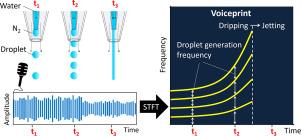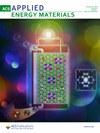基于声纹的同轴微流体设备液滴生成和模式转换传感方法
IF 5.4
3区 材料科学
Q2 CHEMISTRY, PHYSICAL
引用次数: 0
摘要
本研究提出了一种基于声纹的方法,用于感知同轴微流体装置产生的微滴。微液滴在药物输送和分子生物学等多个领域具有重要用途。实时感知微滴的生成对于确保微滴质量控制至关重要。目前的传感技术,如高速视觉,受到成本和系统复杂性的限制。在我们的方法中,使用短时傅立叶变换(STFT)从伴随微液滴产生的声音中提取声纹特征。这些特征用于确定液滴生成频率和模式转换。实验验证使用了一个同轴毛细管微流体设备,该设备能够通过控制内毛细管和外毛细管中水和氮气的流速分别生成 100 微米以下的液滴。实验中成功检测到了几百到几千赫兹的生成频率。此外,利用所提出的声纹方法,还成功实现了对滴-喷和喷-滴模式转换的实时检测。这项工作为传感微流体设备产生的微滴提供了一种简单、稳健且经济高效的解决方案。本文章由计算机程序翻译,如有差异,请以英文原文为准。

Voiceprint-based method for sensing droplet generation and mode transition from a coaxial microfluidic device
A voiceprint-based method is proposed for sensing microdroplets generated from a coaxial microfluidic device in this study. Microdroplet holds significant utility in various fields, such as drug delivery and molecular biology. Real-time sensing of droplet generation is crucial for ensuring droplet quality control. Current sensing techniques, such as high-speed vision, are hindered by cost and system complexity limitations. In our approach, voiceprint features were extracted from the sound accompanying microdroplet generation using the short-time Fourier transform (STFT). These features were employed to determine droplet generation frequency and mode transitions. Experimental validation was conducted using a coaxial capillary microfluidic device capable of generating sub-100-micron droplets via controlled flowrates of water and nitrogen gas in the inner and outer capillaries, respectively. The generation frequency from hundreds to thousands hertz were successfully detected in the experiment. Additionally, real-time detections of dripping-jetting and jetting-dripping mode transition were successfully achieved using the proposed voiceprint method. This work offers a simple, robust and cost-effective solution for sensing microdroplets generated from a microfluidic device.
求助全文
通过发布文献求助,成功后即可免费获取论文全文。
去求助
来源期刊

ACS Applied Energy Materials
Materials Science-Materials Chemistry
CiteScore
10.30
自引率
6.20%
发文量
1368
期刊介绍:
ACS Applied Energy Materials is an interdisciplinary journal publishing original research covering all aspects of materials, engineering, chemistry, physics and biology relevant to energy conversion and storage. The journal is devoted to reports of new and original experimental and theoretical research of an applied nature that integrate knowledge in the areas of materials, engineering, physics, bioscience, and chemistry into important energy applications.
 求助内容:
求助内容: 应助结果提醒方式:
应助结果提醒方式:


